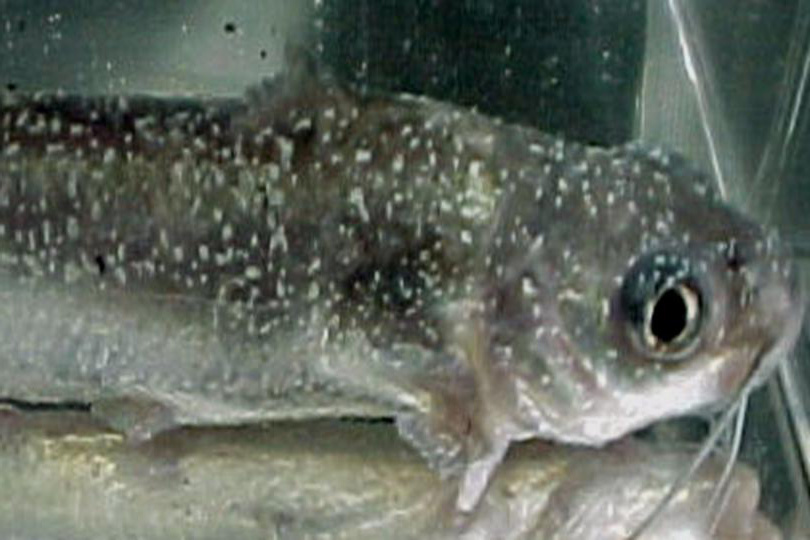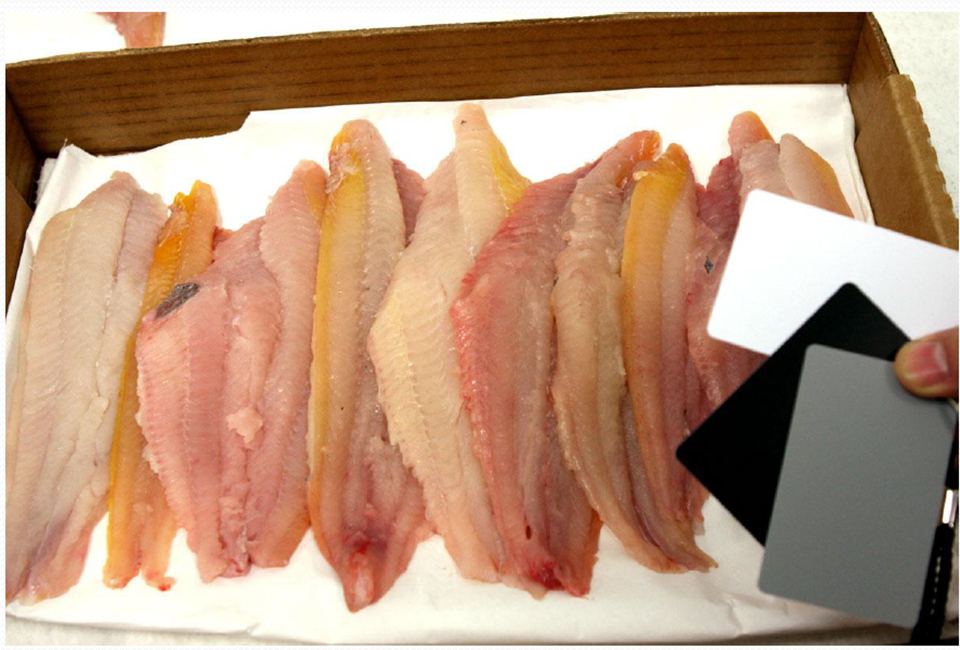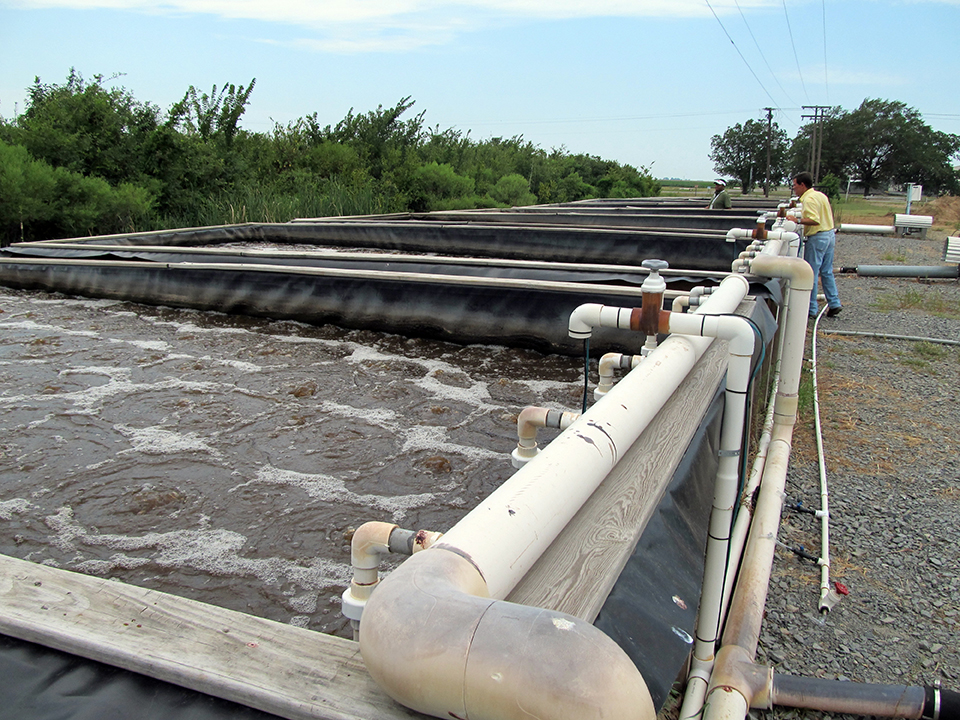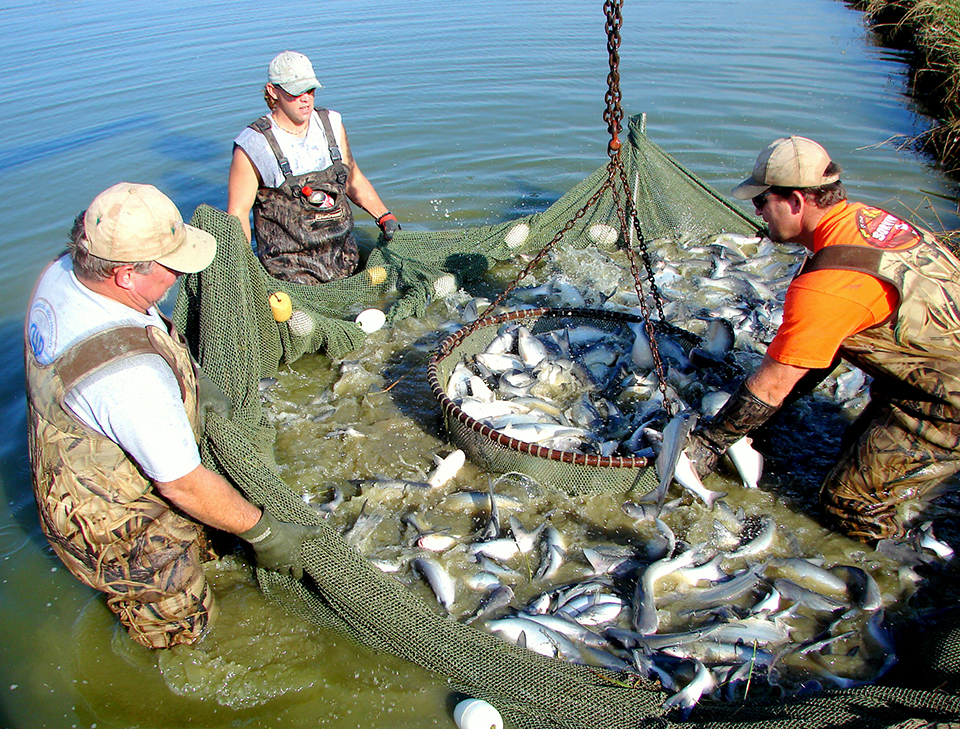Two studies evaluate effects of feeding regimes on growth performance, resistance to infection

Enteric septicemia of catfish (ESC) caused by the bacterium Edwardsiella ictaluri is an infectious disease that causes major economic losses in the channel catfish (Ictalurus punctatus) industry in the southeastern United States. It is widely recognized that appropriate feeding with good-quality feeds is a key factor in sustaining health and maintaining the ability of fish to withstand stress and resist disease-causing agents.
However, a common practice of some channel catfish producers in the U.S. is to withhold feed during the manifestation of ESC. Such practices have reportedly reduced the severity of the disease and decreased mortality. The efficacy of this practice has not been well documented, although a research study with catfish held in net cages reported better survival among fish that received no feed or those fed medicated feed every second or third day.
The authors recently carried out two studies to evaluate the effects of feeding regimes on growth performance and resistance of channel catfish to E. ictaluri infection.
Study setup
In study I, channel catfish of 22.5 g average weight were stocked at 60 fish per l00-l aquarium. In study II, 18.5-g catfish were stocked at 70 fish per aquarium. The aquariums were supplied with flow-through, dechlorinated city water heated to 26-27 degrees C and continuously aerated using air stones. Photoperiod was maintained on a 12 hours light, 12 hours dark schedule.
In both studies, a commercial floating pellet containing 43 percent crude protein was used. Fish in triplicate aquariums were subjected to the following feeding regimens for four weeks: no feeding, once-daily feeding to apparent satiation, feeding every other day to apparent satiation, and no feeding for three weeks followed by once-daily feeding to satiation during week 4. After four weeks, the fish in each aquarium were counted and weighed collectively.
After week 4 in study I, 5 fish per aquarium were intraperitoneally injected with squalene and macrophages (phagocytic white blood cells) harvested five to seven days thereafter for determination of macrophage chemotaxis.
At the end of week 4 in study II, fish from three aquariums of each treatment were pooled, randomly divided into six groups of 25 fish each, and challenged by immersion with E. ictaluri. The study was continued for another two weeks to determine if cessation of feeding during an ESC epizootic reduced fish mortality.
To evaluate this hypothesis, fish in three random aquariums continued to receive the same feeding regimen, whereas those in the other aquariums were switched to no feeding or daily feeding, depending on the feeding regimens used during the first four weeks (Table 1).
Lim, Feeding regimens for channel catfish, Table 1
| Before Challenge | After Challenge |
|---|
Before Challenge | After Challenge |
|---|---|
| Not fed | Not fed |
| Fed daily | |
| Fed daily | Fed daily |
| Not fed | |
| Fed every other day | Fed every other day |
| Not fed | |
| Fed daily at week 4 | Fed daily |
| Not fed |
Feeding effects
In both studies, final weight gains followed the pattern of feed intake and differed significantly among treatments (Table 2). As expected, the unfed fish lost weight, while those fed daily gained the most, and those fed daily at week 4 gained the least. In study I, feed efficiency was significantly highest for the group fed every other day and lowest for the group fed daily at week 4. For study II, however, this parameter did not differ significantly among treatments. There were no significant differences in the survival of fish among treatments in both studies.
Lim, Mean weight gain, feed intake, feed efficiency, and survival of channel catfish receiving various feeding regimens, Table 2,
| Feeding Regimen | Weight Gain (%) | Feed Intake (g dry matter/fish) | Feed Efficiency Ratio | Survival |
|---|
Feeding Regimen | Weight Gain (%) | Feed Intake (g dry matter/fish) | Feed Efficiency Ratio | Survival |
|---|---|---|---|---|
| Study I | ||||
| Not fed | -22.2d | – | – | 99.5a |
| Fed daily | 107.2c | 21.80c | 1.11c | 100.0a |
| Fed every other day | 73.7b | 12.89b | 1.29b | 100.0a |
| Fed daily at week 4 | 16.2a | 4.31a | 0.84a | 98.8a |
| Study II | ||||
| Not fed | -21.6d | – | – | 91.7a |
| Fed daily | 140.5c | 20.17c | 1.29a | 100.0a |
| Fed every other day | 72.5b | 10.59b | 1.27a | 98.6a |
| Fed daily at week 4 | 23.5a | 3.69a | 1.18a | 95.7a |
Feeding regimen had no effect on macrophage migration in the absence of exoantigen produced by E. ictaluri (Table 3). In the presence of exoantigen, mean macrophage migration significantly differed among treatments. The unfed group had the lowest mean macrophage migration, followed in increasing order by the groups fed daily at week 4, fed every other day, and fed daily. The macrophage chemotaxis ratio of the unfed group was similar to that of the group fed daily at week 4, but both of these values were significantly lower than those of the other groups. The value of this parameter was highest for fish fed daily.
Lim, Mean macrophage migration and macrophage chemotaxis ratio of channel catfish receiving various feeding regimens for four weeks in study I, Table 3
| Feeding Regimen | Mean Macrophage Migration Without Exoantigen | Mean Macrophage Migration With 50 µl Exoantigen | Macrophage Chemotaxis Ratio |
|---|
Feeding Regimen | Mean Macrophage Migration Without Exoantigen | Mean Macrophage Migration With 50 µl Exoantigen | Macrophage Chemotaxis Ratio |
|---|---|---|---|
| Not fed | 1.27a | 2.87d | 0.69a |
| Fed daily | 1.51a | 6.18c | 0.81c |
| Fed every other day | 1.44a | 4.44b | 0.76b |
| Fed daily at week 4 | 1.58a | 3.69a | 0.70a |
The average times to first mortality after challenge with E. ictaluri were lowest for the groups that were not fed throughout the study, not fed for the first four weeks and then fed daily, or fed daily at week 4 and then not fed thereafter (Table 4). The group fed every other day throughout the study had the highest number of days to first mortality, but this was not significantly different from those of the groups fed daily throughout the study, fed daily for four weeks then not fed, fed every other day for four weeks then not fed, and fed daily during weeks 4-6.
Lim, Mean days to first mortality and cumulative mortality of channel catfish receiving various feeding regimens (study II), Table 4
| Feeding Regimen | Days to First Mortality | Cumulative Mortality (%) |
|---|
Feeding Regimen | Days to First Mortality | Cumulative Mortality (%) |
|---|---|---|
| Not fed throughout study | 3.7a | 100.0c |
| Not fed for four weeks, then fed daily | 3.3a | 98.7c |
| Fed daily throughout study | 7.0c | 25.3a |
| Fed daily for four weeks, then not fed | 4.3bc | 53.3ab |
| Fed every other day throughout study | 8.0c | 32.0ab |
| Fed every other day for four weeks, then not fed | 6.0bc | 53.3ab |
| Fed daily at week 4, then fed daily | 6.7c | 54.7ab |
| Fed daily at week 4, then not fed | 4.0ab | 60.0b |
All of the fish that were not fed throughout the study died within eight days of challenge. Almost 99 percent of those not fed for four weeks and then fed daily died by the end of two weeks postchallenge.
These values were significantly higher than those of the other treatments. The group fed throughout the study had significantly lower mortality than that fed daily at week 4 and then not fed. Neither value, however, differed significantly from those of the groups fed daily for four weeks and then not fed, fed every day throughout, fed every other day for four weeks and then not fed, or fed daily weeks 4-6.
(Editor’s Note: This article was originally published in the July/August 2006 print edition of the Global Aquaculture Advocate.)
Now that you've reached the end of the article ...
… please consider supporting GSA’s mission to advance responsible seafood practices through education, advocacy and third-party assurances. The Advocate aims to document the evolution of responsible seafood practices and share the expansive knowledge of our vast network of contributors.
By becoming a Global Seafood Alliance member, you’re ensuring that all of the pre-competitive work we do through member benefits, resources and events can continue. Individual membership costs just $50 a year.
Not a GSA member? Join us.
Authors
-
Chhorn Lim, Ph.D.
Aquatic Animal Health Research Unit
USDA-ARS, MSA
P.O. Box 952
Auburn, Alabama 36831-952 USA -
Mediha Yildirim-Aksoy, Ph.D.
Aquatic Animal Health Research Unit
USDA-ARS, MSA
P.O. Box 952
Auburn, Alabama 36831-952 USA -
Phillip H. Klesius, Ph.D.
Aquatic Animal Health Research Unit
USDA-ARS, MSA
P.O. Box 952
Auburn, Alabama 36831-952 USA
Tagged With
Related Posts

Health & Welfare
Antigens provide immunity against ich in channel catfish trials
Vaccination against the Ich parasite is an alternative to chemical treatment. Fish develop a humoral immune response to trophont antigens, with the degree of protection related to the immunizing doses of trophonts used.

Innovation & Investment
Assessing coloration in channel catfish fillets
Because consumers look at color to gauge quality of catfish fillets, the authors developed a digital photography measurement method to assess yellowness.

Health & Welfare
Biofloc technology reduces common off-flavors in channel catfish
In studies that used biofloc systems to culture channel catfish, culture tanks were susceptible to episodes of geosmin and 2-methylisoborneol and subsequent bioaccumulation of off-flavors in catfish flesh.

Health & Welfare
Blue catfish outproduce channel catfish under low-D.O. conditions
Although there is increasing interest in blue catfish, a potential disadvantage of the fish when compared to channel catfish is their reported poorer tolerance of low dissolved-oxygen concentrations.


